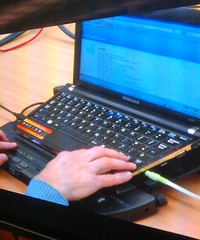 Image by psd via FlickrThe range of assistive technology for visually impaired learners has grown over the last few years, with interactive experiences becoming more sophisticated and applications becoming less clunky. Different media (visual, auditory and tactile) have been developed to help students to study independently, and to empower them to create their own resources and artefacts.
Image by psd via FlickrThe range of assistive technology for visually impaired learners has grown over the last few years, with interactive experiences becoming more sophisticated and applications becoming less clunky. Different media (visual, auditory and tactile) have been developed to help students to study independently, and to empower them to create their own resources and artefacts.This resource aims to collate a few of those resources in one place for you to explore to see if they would suit your learners and their needs.
A good place to start is with this paper "ICT educational tools and visually impaired students: different answers to different accessibility needs", which discusses some of the obstacles faced by visually impaired learners, as well as providing an overview of some examples of Web based tools available to help meet the needs of visually impaired students. A complementary resource, this Unit offers a series of scenarios that give ideas about how to incorporate ICT into teaching and provide access for those students with visual disabilities. In addition, this document "ICT Tools for Visually Impaired Persons – Examples" provides in-depth descriptions of the types of assistive technology available. It also has links to some presentations and further information around building the capacity of visually impaired individuals to use technology tools.
Please let me know if you have any to add, or if you have opinions and comments about any of the resources.
Digital Book Readers
Most people are now familiar with digital book or e-readers. There are a range to choose from, and most have an option for text to be 'read' aloud by the device.
- The Kindle - from Amazon (read a review with an in depth description, for this device)
- The Sony Reader
- eClipseReader - from Innovative Rehabilitation Technology
- Victor Reader Soft - from VisuAide
An application installed onto a computer and that will identify, interpret and 'read' aloud any text on the screen. Although some screen readers have a rather robotic sounding narrator, many have reasonably well-modulated speech, with pauses in most of the right places.
- A collection of annotated links to free and commercial screen readers, with a brief description of the functionality of each piece of software
- This resource has a range of free text to speech readers with descriptions
- NaturalReader from NaturalSoft
- JAWS from Freedom Scientific
 Image via Wikipedia
Image via WikipediaScreen magnification software can be installed onto a computer to enlarge the information on the monitor screen (ranging from 2x all the way to 20x). The applications listed below are all commercial software and have an associated cost:
- Freedom Scientific Video Magnifiers
- Ai Squared Zoom Text (who also have a zoom app for the iPhone)
These are, as the title suggests gizmos that provide speech output without a visual display. You are able to connect them to devices such as computers, scanners and printers to upload text. Braille keyboards are also available for Braille users.
- Braille Lite Series; Braille n'Speak, Type n'Speak, PacMATE, and Type Lite - all from Freedom Scientific
- VoiceNote and BrailleNote - from Pulse Data in NZ






1 comment:
checkout these post about ict
ICT - Raising Standards and improving the quality of education
ICT and Raising Standards
Recent research also points to ICT as a significant contributory factor in the raising of standards of achievement in schools.
Examples of ICT-based activities
What kind of classroom activities are suited to the use of ICT? The following is a brief guide to some of the most common uses of ICT in teaching and learning.
Benefits of ICT in Education - General benefits, Benefits for teachers, students and parents
Benefits which ICT brings to education according to recent research findings
Role of ICT in Professional development
Meaning of Professional development
Approaches to professional development and Role of ICT
There are a variety of approaches to professional development, including consultation, coaching, and communities of practice, lesson study, mentoring, reflective supervision and technical assistance.
Post a Comment